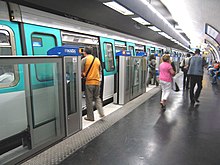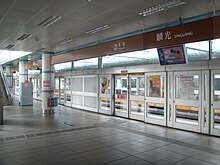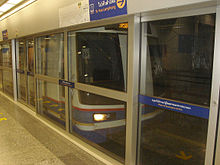Platform screen doors: Difference between revisions
| Line 121: | Line 121: | ||
*[http://www.platformscreendoors.com/ Westinghouse website on PSDs] - Includes video of doors in action, pictures, diagrams, and other info. |
*[http://www.platformscreendoors.com/ Westinghouse website on PSDs] - Includes video of doors in action, pictures, diagrams, and other info. |
||
*[http://mic-ro.com/metro/platform-screen-doors.html Platform screen doors] Metro Bits |
*[http://mic-ro.com/metro/platform-screen-doors.html Platform screen doors] Metro Bits |
||
* [http://www.oclap.com/ Oclap website on PSDs] - Presentation of the new product [http://www.oclap.com/inglese/pdd.asp Platform Dynamic Doors] |
|||
[[Category:Rapid transit]] |
[[Category:Rapid transit]] |
||
Revision as of 16:12, 26 August 2010
It has been suggested that Automatic platform gate be merged into this article. (Discuss) Proposed since April 2008. |















Template:FixBunching Platform screen doors (PSDs) and platform edge doors (PEDs) at train or subway stations screen the platform from the train. They are a relatively new addition to many metro systems around the world, with some platform doors retrofitted rather than installed with the metro system itself. They are widely used in Asian and European metro systems. Cities with metro systems that employ platform screen doors include Tokyo, Kyoto, Osaka, Nagoya, Yokohama, Kobe, Fukuoka,Sapporo,Sendai, Seoul, Busan, Daejeon, Daegu, Incheon, Gwangju, Dubai, Hong Kong, London, Taipei, Kaohsiung, Beijing, Tianjin, Shanghai, Guangzhou, Shenzhen, Chongqing, Kuala Lumpur, Singapore, Bangkok, Copenhagen, Paris, Rennes, Toulouse, Lille, Torino, St. Petersburg, Barcelona, Seville, and São Paulo.
Door types
Although the terms are often used interchangeably, platform screen doors are full height, total barriers between the station floor and ceiling, while platform edge doors are full height, but do not reach the ceiling and thus do not create a total barrier.
These doors help:
- Prevent accidental falls off the platform onto the lower track area, suicide attempts and homicides by pushing.
- Reduce the risk of accidents, especially from service trains passing through the station at high speeds.
- Improve climate control within the station (heating, ventilation, and air conditioning are more effective when the station is physically isolated from the tunnel).
- Improve security - access to the tracks and tunnels is restricted.
- Lower costs - eliminate the need for motormen or conductors when used in conjunction with Automatic Train Operation, thereby reducing manpower costs.
- Prevent litter build up on the track which can be a fire risk.
Usage
Russia
Park Pobedy (Russian: Парк Побе́ды) is a station of the Saint Petersburg Metro that was the first station in the world with screen doors. The station was opened in 1961. Later the other nine stations of this type were built in Saint Petersburg (Leningrad). There was an electronic device to ensure that the train stopped with its doors adjacent to the platform doors; they were installed so that driverless trains could eventually be used on the line.[3] Unlike other platform screen doors, which are lightweight units with extensive glazing installed a normal platform edge, the St Petersburg units give the appearance of a solid wall with heavyweight doorways and solid steel sliding doors, like exist for a bank of elevators in a large building, and the train cannot be seen entering from the platform; passengers become familiar with the sound alone to indicate a train arrival.
Singapore
The Singapore Mass Rapid Transit (MRT) was the first rapid transit system in Asia to incorporate platform screen doors in its stations in 1987.[4] Full height platform screen doors are installed at all existing underground MRT stations in Singapore and all future underground MRT stations. Half height platform screen doors will be retrofitted into all existing elevated MRT stations by 2012 (starting with three elevated MRT stations by 2009), as well as all future elevated MRT stations.
There are two series of the full height platform screen doors in use. The first series was installed at all underground stations along the North South Line and the East West Line from 1987 to the completion of the initial system in 1990. The second series of platform screen doors sporting a sleeker design, producing less sound when the doors were opened and closed, and incorporating more glass were installed in the Changi Airport MRT Station which opened in 2002. All stations in the fully-underground North East Line, which opened in 2003, also sport these new doors. The upcoming MRT Line, the Circle Line will also feature second-generation platform screen doors on all of its stations. These doors were also installed on the North South Line platform in the Bishan MRT Station.
Considered a novelty at the time of its installation, it was introduced primarily to minimise hefty air-conditioning costs, especially since elevated stations are not air-conditioned, and hence are much more economical to run in comparison. Since then the safety aspects of these doors have become more important, as highlighted by a series of high profile incidents where individuals were injured or killed by oncoming trains since the year 2002, all occurring on elevated stations where no screen doors exist. The Land Transport Authority (LTA) reports that there have been more than 220 cases of commuters trespassing on the tracks between 1991 and 15 September 2004, of which 87 percent were deliberate acts of trespass. Nine fatalities were recorded during this period, of which only one was an accident. Since September 2004 there have been six fatalities occurring on elevated MRT and LRT stations.
Hong Kong
In 1998, the Tung Chung Line and Airport Express saw the earliest operations of platform screen doors in Hong Kong. In 2000, the MTR Corporation began a six year programme to add 2,960 pairs of platform screen doors at 30 underground MTR stations on the Kwun Tong Line, Tsuen Wan Line, and Island Line. This was the world's first railway to retrofit Platform Screen Doors on a transit system already in operation. The project was completed in October 2005.[5] Platform screen doors are now operated in 51 stations. The world's longest platform screen doors are located in East Tsim Sha Tsui Station.
The West Rail Line was built by the Kowloon-Canton Railway Corporation (KCRC) before the MTR-KCR merger. During the construction of this railway line, platform screen doors were installed on all the platforms in all the stations along the railway line.
Taiwan
Platform screen doors were installed from the beginning with the opening of the Wenshan Line (Taiwan's first metro line) on the Taipei Metro in 1996. Since then, the Neihu Line extension as well as future lines and stations will be equipped with them.
All underground stations on the Kaohsiung MRT system have platform screen doors installed.
Mainland China
A number of Chinese cities have started installing platform screen doors. Systems such as Guangzhou Metro and Shenzhen Metro have adapted the platform screen doors while Shanghai Metro and Beijing Subway have begun installing the doors at most stations.
Japan
The Tokyo Metro Namboku Line is fitted with platform screen doors, as is the Kyoto Municipal Subway Tōzai Line.
Korea
Yongdu Station of Seoul Subway Line 2 was the first station on the Seoul Subway to feature platform screen doors; the station opened in October 2005. Since then many underground stations have since been opened or retrofitted with platform screen doors.
Denmark
The Copenhagen Metro uses Westinghouse[6] platform screen doors on all underground stations platforms.
Spain
Platform screen doors were first installed on Barcelona Metro line 11 for testing purposes before fitting them on all stations for the new lines 9 and 10, which operate driverless.
France
The Paris Métro lines 1 and 14 have platform screen doors, currently under construction as of 2010 in the former.
United Kingdom
The Jubilee Line extension project saw platform edge doors installed on its new stations. They were designed primarily to reduce the movement of air caused by emergency ventilation fans which activate in event of a fire, or under test conditions. They were also built as a barrier to prevent people falling or jumping onto the tracks.
The Jubilee Line PEDS were produced by Westinghouse.[7]
United States and Canada
In Chicago, the Airport Transport System (ATS) operates 24 hours a day at O'Hare International Airport. ATS is a 2.5 mile long (4 km) line that operates between the four current terminals at the airport and parking areas. Each station is fully enclosed with platform edge doors allowing access to the automated trains.
In New York City, the Port Authority of New York and New Jersey utilizes full height platform screen doors at all of its Airtrain JFK stations. Several planned stations in the New York City Subway may possibly feature platform screen doors. This includes the Flushing line extension,[8] and the Second Avenue Subway.[9]
Automated people-mover systems at numerous American and Canadian airports also make use of platform screen doors. The Las Vegas monorail system has these doors as well.
Toronto subway system plans to begin the process of adding screen doors at select subway stations on the Yonge line beginning in 2013 and completion on the Yonge-University-Spadina line by 2015.[10] The remaining Bloor-Danforth and Sheppard lines will not have screen doors until new train sets, dubbed the Toronto Rocket, begin running on these lines and all older cars are retired from the entire system. There are no plans for the Scarborough RT as the system's future is still under debate.
Screen doors are already in use at all three LINK Train stations at Toronto Pearson International Airport in Mississauga, Ontario.
Brazil
The São Paulo Metro currently has three stations with platform screen doors (PSDs): Sacomã station (Line 2 - Green) opened on January 30, 2010 with this feature. On May, 25 2010 Faria Lima and Paulista stations (Line 4 - Yellow) also opened featuring PSDs. All the future stations of the system will be inaugurated with PSDs, and it is planned to be installed in the old stations as well.[11]
Accidents
On 15 July 2007 in Shanghai, platform-edge doors led to a fatal accident. A man tried to force his way onto a crowded train at the station for the Shanghai Indoor Stadium, but failed. When the doors closed, he was sandwiched between closed doors and pulled under the train, leading to his death.[12]
See also
References
- ^ "Platform Screen Doors, KABA". Kaba.com. Retrieved 2009-08-01.
- ^ "Platform Screen Door Location, Paris - Ligne 13 - St. Invalides". Maps.google.de. 1970-01-01. Retrieved 2009-08-01.
- ^ Cooke, B.W.C., ed. (1959). "Sliding Doors on Platform Edge". The Railway Magazine. 105 (703). Westminster: Tothill Press: 796.
{{cite journal}}: Unknown parameter|month=ignored (help) - ^ Westinghouse Platform Screen Doors - Completed Projects[dead link]
- ^ "LCQ16:Retrofitting of PSDs at MTR stations to be completed by 2006". HKSAR Government Information Centre. 2005-01-05. Retrieved 2007-06-17.
- ^ "WPSD Platform Screen Door System - Case Study". Platformscreendoors.com. Retrieved 2009-08-01.
- ^ "Westinghouse Platform Screen Doors". Platformscreendoors.com. Retrieved 2009-08-01.
- ^ MTA Plans To Install Platform Doors On 7 Line Extension, NY1, 8 September 2007
- ^ Glass walls, sliding doors on 2nd Ave. subway?, WABC-TV, April 5, 2007
- ^ TTC plans suicide barriers on Yonge line
- ^ [1], São Paulo Metro Official website
- ^ "Man caught between subway train and safety doors dies in Shanghai - International Herald Tribune". International Herald Tribune. 2009-03-29. Retrieved 2009-08-01.
- Oclap website on PSDs - Presentation of the new product Platform Dynamic Doors
External links
- Westinghouse website on PSDs - Includes video of doors in action, pictures, diagrams, and other info.
- Platform screen doors Metro Bits
- Oclap website on PSDs - Presentation of the new product Platform Dynamic Doors
